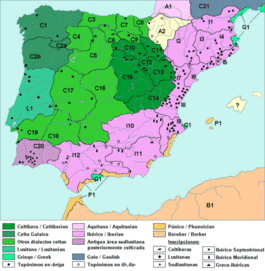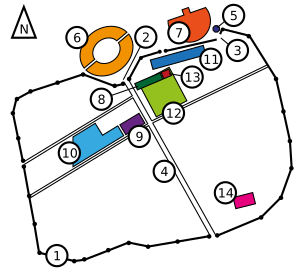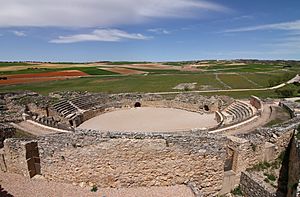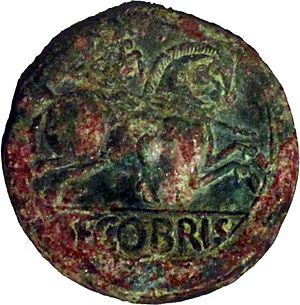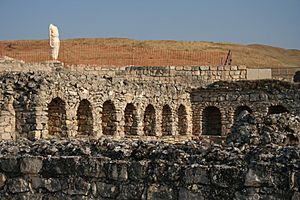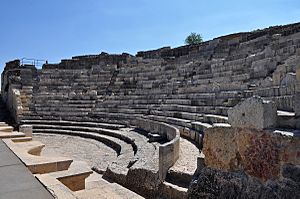Segobriga facts for kids
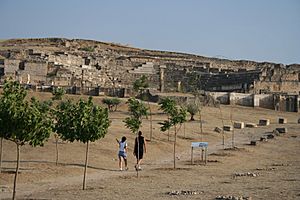 |
|
| Location | Spain |
|---|---|
| Region | Castile–La Mancha |
| Coordinates | 39°53′06″N 2°48′47″W / 39.885°N 2.813°W |
Segóbriga was a really important ancient city, first for the Celts and then for the Romans. Today, you can visit its amazing ruins on a hill called cerro Cabeza de Griego, close to the town of Saelices in Spain. Scientists have found many old buildings here. These buildings have been carefully saved and you can see them in the Archaeological Park.
Segóbriga became a National Monument on June 3, 1931. Now, it's known as a Bien de Interés Cultural, which means it has special legal protection as a cultural treasure. Even though it's in ruins, Segóbriga is very well preserved compared to other ancient sites in the Iberian Peninsula. Walking around the site helps you imagine what life was like in these old cities long ago.
Contents
What's in a Name?
The name Segóbriga comes from two words in the Celtiberian language. This was an old language from the Indo-European Celtic family that is no longer spoken.
The first part, Sego-, means victory. You can see this part in other city names like Segovia and Segorbe. The second part, -briga, usually means city or fortress. This ending is also found in other old names from the Celtiberian area, like Juliobriga. So, Segóbriga probably means "Victory City" or "Triumphant Fortress".
A Look Back in Time
In 1888, archaeologists found a very old burial site from the Bronze Age (around 2000 BC). This was in a cave called cueva de Segóbriga, near the cerro de Cabeza de Griego. The cave was dug out of limestone. The tombs belonged to a Celtiberian group of people. This discovery was shared with the world in 1893. They found human bones, tools, and other items from daily life.
Experts think Segóbriga started as a Celtiberian fortress on a hill. It looked over the land to the north. The Cigüela river acted like a natural moat, making it a good defensive spot. We haven't found the fortress itself, but a piece of pottery from the 5th century BC shows people lived here a very long time ago.
The first time Segóbriga was written about was by a Greek geographer named Strabo. He mentioned that a Roman general, Quintus Caecilius Metellus Pius, fought in the Wars of Sertorius. These wars happened in the Celtiberian area, near cities like Bílbilis and Segóbriga. This tells us Segóbriga was right in the middle of Celtiberian lands. The area, once home to the Olcades tribe, was taken over by the Romans after these wars.
Old texts from the 3rd and 2nd centuries BC help us know about the people living in this area. The Olcades lived near the Cuenca mountains. The Lusones were closer to La Alcarria and province of Guadalajara. The Carpetani lived towards Toledo. So, the people of Segóbriga were likely Olcades or Carpetani. About 7 kilometers away, there's another ancient site called Villas Viejas. This site is linked to Contrebia Carbica, a Carpetani city.
Roman Times
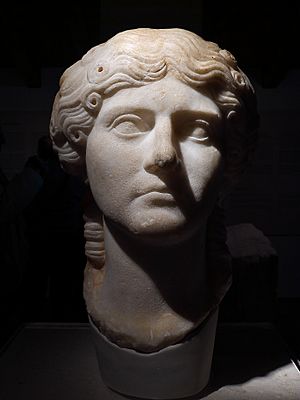
After the Romans conquered the area in the early 2nd century BC, during the Celtiberian Wars, Segóbriga became an oppidum, which was a Celtiberian city. After the wars of Sertorius (around 80-72 BC), Segóbriga became the main center for a large part of the Meseta Central region.
Around 12 BC, during the time of Emperor Augustus, Segóbriga stopped being a city that paid tribute to Rome. Instead, it became a municipium. This meant it was ruled by Roman citizens, which greatly increased its importance. This led to a big economic boom and many new buildings. These building projects likely finished around 80 AD, during the Flavian period. This is when public entertainment buildings and the city wall you see today were built.
Segóbriga was also an important place for travel and communication. During this time, the city even made its own money at its mint. By the end of Emperor Vespasian's rule, Segóbriga was at its peak. The theater and amphitheater were finished, and the city was fully part of the Roman Empire.
Archaeological finds show that in the 3rd century AD, important wealthy families still lived in Segóbriga. However, by the 4th century, these families had left the main monuments. This shows the city was slowly becoming less important and turning into a rural area.
Later Periods
During the Visigoth period, starting in the 5th century, Segóbriga was still an important city. Remains of several churches (basilicas) and a large burial ground (necropolis) have been found from this time. Bishops from Segóbriga even attended important church meetings called Councils of Toledo. For example, they were at the Third Council of Toledo in 589 and the Sixteenth Council of Toledo in 693.
The city likely became completely empty after the Muslim invasion of the Iberian Peninsula. Its bishops and leaders probably fled north to Christian kingdoms, just like what happened in the nearby city of Ercavica. From this time, there are remains of a Muslim fort at the top of the hill.
After the Reconquista (when Christian kingdoms took back Spain), people from the area moved to the current town of Saelices. This town is about 3 kilometers north, next to the spring that supplied water to Segóbriga's aqueduct. Segóbriga was forgotten, and the hill it stood on became known as "Cabeza del Griego." A small group of people lived there, connected to the town of Uclés. They even used stones from Segóbriga's ruins to build the convent-fortress in Uclés.
Over time, Segóbriga was slowly abandoned even more. Only a small chapel built on the old Monumental Baths remained. This chapel was the last part of the ancient city that survived until today.
Protecting Segóbriga
The beautiful landscape around the Archaeological Park of Segóbriga is currently at risk. A company called Energías Eólicas de Cuenca plans to build a wind farm nearby. This project would involve putting up 14 wind turbines, each 121 meters tall. These turbines would change the look of the area and also affect the Historic Site of Uclés. Because of this, the Segóbriga Archaeological Park and the Historical Site of Uclés have been added to the Red list of endangered heritage by the group Hispania Nostra, which works to protect historical sites.
What You Can See at Segóbriga Today
Celtiberian Structures
- The necropolis (a burial ground outside the city walls).
Roman Structures
- The city wall and the North Gate.
- The Amphitheater of Segóbriga: This huge oval building was used for gladiator fights and other shows. It could hold 5,500 people.
- The Theater: Built in the first century, this was where plays and performances took place.
- The Monumental Thermaes (Baths): These large public baths were not just for washing. They were also places for people to meet and do business.
- The theater's gym and smaller baths.
- The Forum: This was the main public square, the center of city life.
- The Acropolis: The highest part of the city, often with important buildings.
- The rock sanctuary of Diana (a religious site outside the walls).
- The aqueduct (a structure that carried water into the city, located outside the walls).
- The quarries (places where stone was dug out, outside the walls).
- The circus (outside the walls): Recent studies show this building was started on top of a burial ground but was never finished.
Visigoth Structures
- The basilica of Cabeza de Griego (a church outside the walls).
See also
 In Spanish: Segóbriga para niños
In Spanish: Segóbriga para niños
- Archaeological Park of Segóbriga
- Antonio Tavira y Almazán



